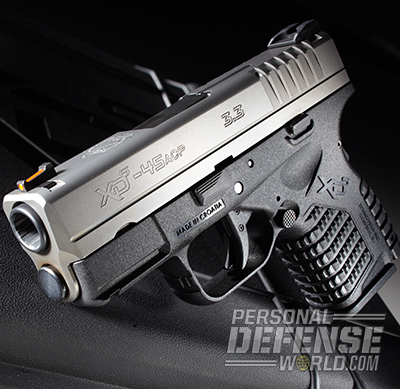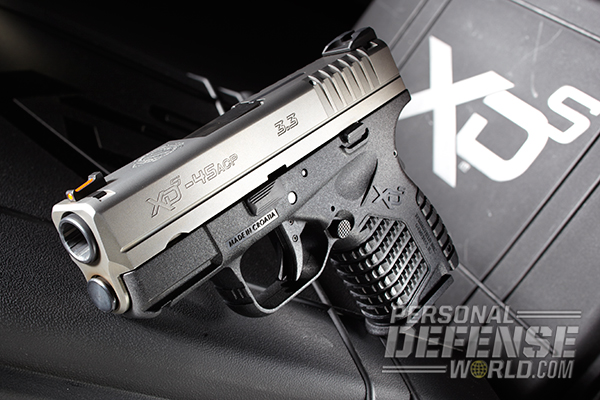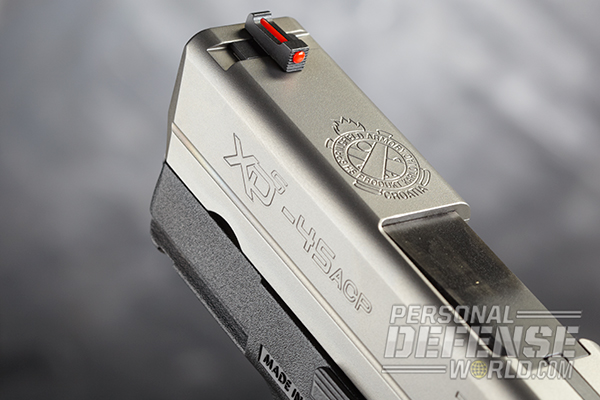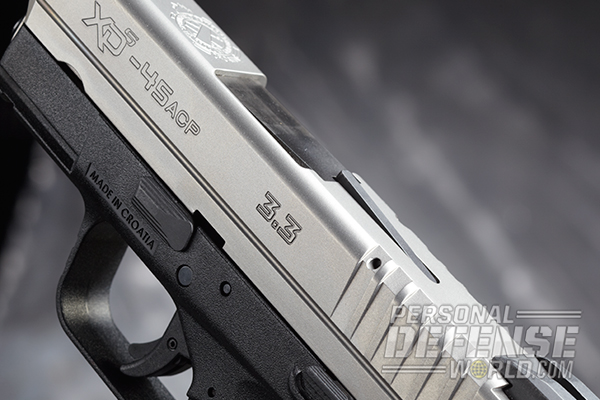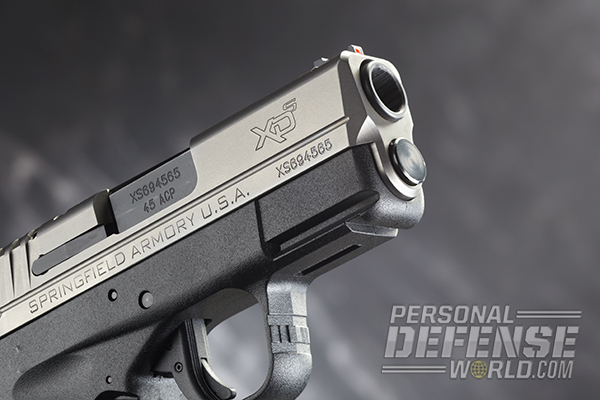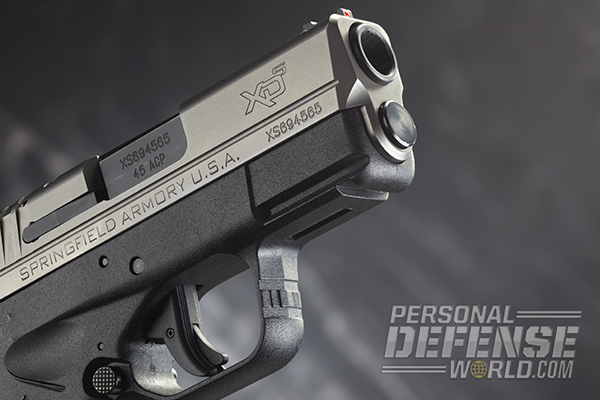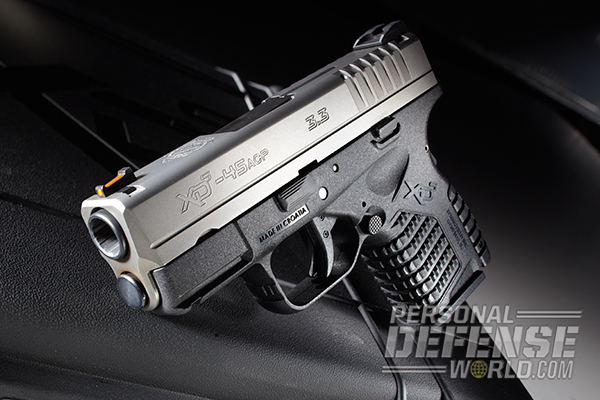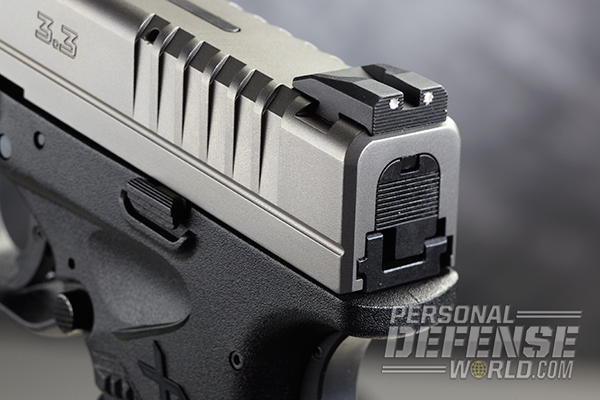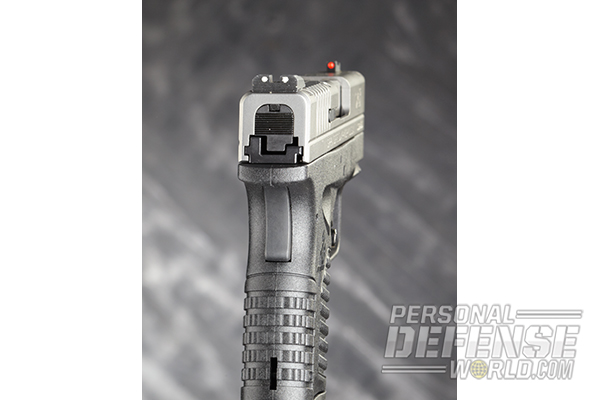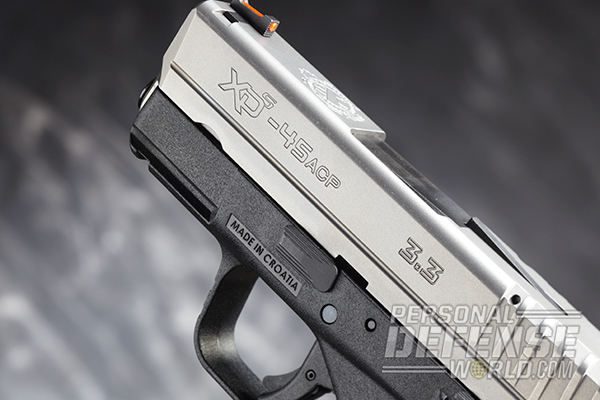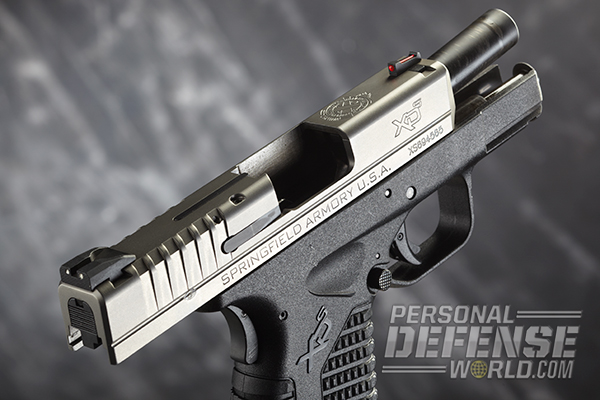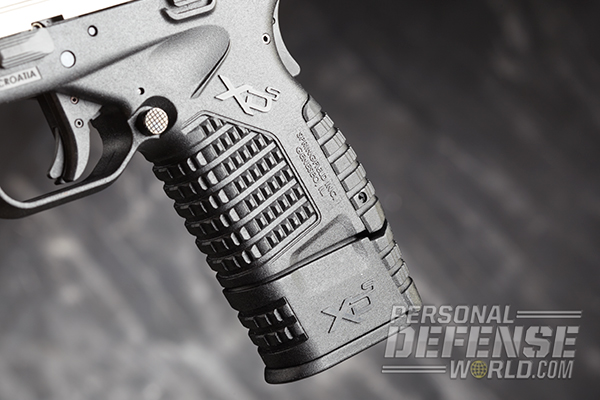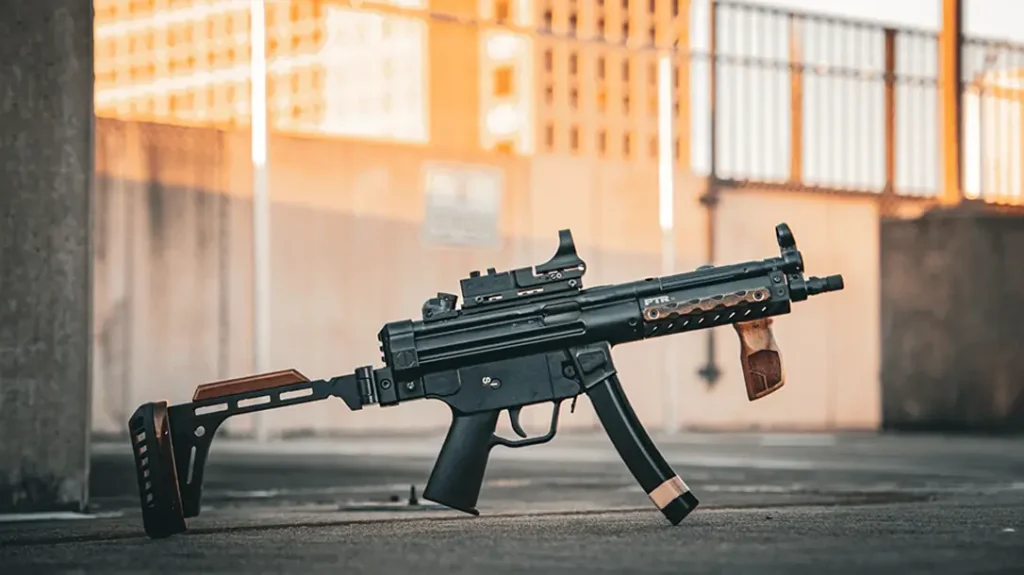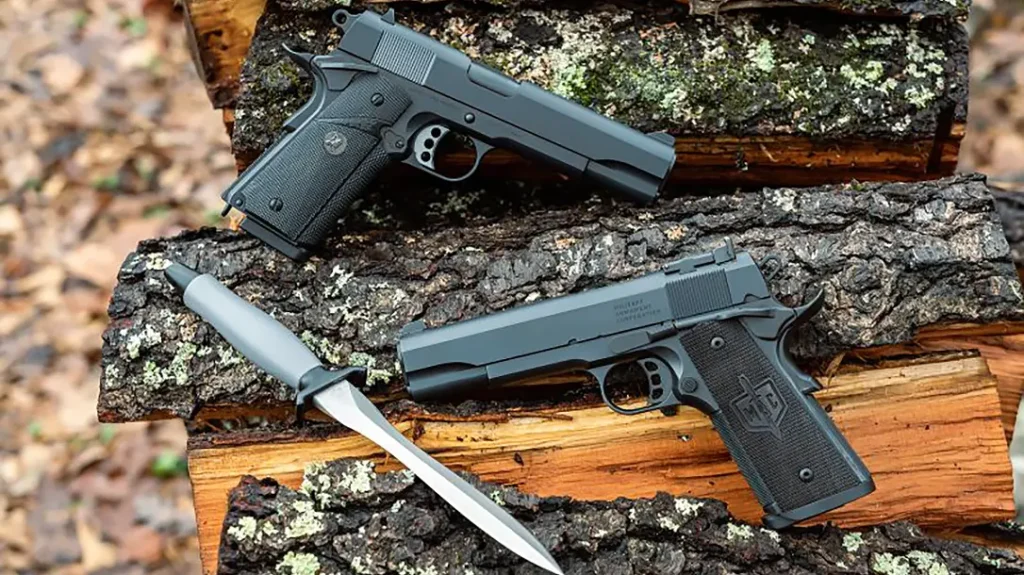In 2012 Springfield Armory rewrote the book on large-caliber, concealed-carry handguns with its introduction of the XD-S 3.3 semi-auto. As the smallest semi-automatic .45 ACP ever developed, the XD-S became the blueprint for the 9mm model that followed, as well as for the latest .45 ACP and 9mm models, which were introduced this year. Externally, the new models look almost identical to the 2012 edition; internally, there is a difference in the internal operation of the grip safety, which has been redesigned along with the sear, grip safety spring and sear spring. Another minor internal upgrade has also improved trigger operation by smoothing out trigger pull. The only external difference, however, is a small roll pin added to the grip safety in order to distinguish the new models.
For more on the XD-S and other products from Springfield, please visit Springfield-Armory.com.
All XD-S semi-autos have two external safety mechanisms, the Ultra Safety Assurance (USA) toggle trigger (which is what most semi-autos with blade-type trigger safety systems rely upon solely) combined with a secondary 1911-type grip safety. Both must be properly engaged in order for the XD-S to fire. Another advantage is that XD-S models will discharge a chambered round with the magazine removed. Not having a magazine disconnect is one of those debatable features, but most individuals who rely on a firearm for personal defense favor semi-autos that can operate without a magazine just in case. “In case of what?” you ask. The possibilities are as simple as losing a magazine in a confrontation (an antagonist manages to hit the magazine release in a struggle), or being in the middle of a tactical magazine change when you suddenly have to fire the gun, to something as grim as not being able to reload a magazine and having only enough time to drop a single round into the chamber and release the slide to fire. An unlikely scenario perhaps, but unlikely isn’t the same thing as impossible.
Advertisement — Continue Reading Below
The XD-S series is about more than just achieving size reduction; it is about building a semi-auto that is also strong enough to handle modern .45 ACP personal defense and law enforcement ammunition while remaining both controllable and accurate. Building a subcompact .45 ACP handgun that meets these requirements has been the goal of everyone from Colt (as far back as the 1950s) to custom gunmakers like Detonics (in the late 1970s) to contemporary manufacturers like Springfield Armory.
The improved XD-S .45 is the latest within Springfield’s numerous variations of .45 ACP semi-autos derived from the XD and XDM lines. While the larger XD series (available in 9mm, .40 S&W and .45 ACP) found great acceptance within the general firearms community, the smaller XDM became one of the most popular personal-protection .45 ACP semi-autos and led the company to think even smaller with the .40 S&W XDM Compact. This ultra-compact pistol raised the bar even higher and set Springfield’s designers on the path to developing the XD-S. Building a gun that would be smaller than the XDM Compact and chambered in .45 ACP became their number-one goal.
Advertisement — Continue Reading Below
Gun Details
Part and parcel of building a smaller .45 was maintaining a reasonable 5+1 standard capacity in .45 ACP, and achieving excellent weight and balance in the hand to reduce recoil. Internally, the gun’s specialized recoil spring-and-plunger design helps mitigate the recoil one might expect from a comparatively lightweight, polymer-framed handgun, making the XD-S more manageable and quicker to get back on target than expected—quicker in fact than many larger .45 ACP subcompacts.
“Despite having two external safeties, the XD-S has a clean, uncluttered profile …”
Advertisement — Continue Reading Below
The XD-S .45 utilizes a striker-fired system that Springfield Armory has fine-tuned to reduce trigger take-up and enable a short reset. Including engagement of the blade trigger safety, there is about 0.5 inches of travel, and the trigger pull remains crisp and consistent with every shot, requiring a nominal 6.875 pounds on average. This is slightly heavier than first-generation XD-S models, and it comes as a result of internal changes to the action. Nevertheless, for a striker-fired semi-auto, it remains a comparatively light trigger with negligible stacking and overtravel. Technically, the trigger system on striker-fired pistols is neither a single action (SA) nor a double action (DA), since there is no hammer for the trigger to act upon. The same argument can be made for any striker-fired semi-auto, but more often than not you’ll see them described as SA/DA (and some actually are). Despite this, they are mostly regarded as double-action-only (DAO) designs. In terms of actual operation, one would have to define the firing system of the XD-S as single-action-only (SAO), since the gun cannot be de-cocked after a round is chambered; it also does not have second-strike capability. However, resetting the striker manually only requires pulling the slide rearward 0.25 inches.
Despite having two external safeties, the XD-S has a clean, uncluttered profile with a slightly raised slide release and a beveled takedown lever, both on the left side of the frame. Neither has an edge likely to catch on clothing or impede draw or re-holstering. The checkered, ambidextrous magazine releases are slightly angled and require a firm press to operate. There is also a loaded-chamber indicator that can be seen and, more importantly, felt should the user find him or herself in a situation that makes a visual check impractical. The loaded-chamber indicator is located behind the ejector port on top of the slide. The front edge projects upward when a round is chambered—just enough to either see it under your line of sight, or surreptitiously feel it by running a finger over the top of the slide. Additionally, if the trigger has been pulled and the action hasn’t cycled, it will lock back at its rearmost position. When the action is cycled the trigger extends forward 0.62 inches to the ready position. That, however, does not guarantee that a round is chambered, only that the gun is ready to fire; thus, the loaded-chamber indicator is a very important feature.
Given the gun’s modest weight of 21.5 ounces empty, and its overall length of 6.3 inches with a 3.3 inch barrel, height of 4.4 inches from the base of the magazine to the top of the rear sight and slide width of 0.9 inches, the XD-S fits into multiple concealed-carry categories—from subcompact to pocket pistol. With the latest internal improvements, the new generation for 2014 is an even better handling gun with its improved trigger pull and internal safety upgrades.
Advertisement — Continue Reading Below
Standard features on all XD-S .45 ACP and 9mm models include drift adjustable front and rear sights (white dots rear and red fiber-optic front), ambidextrous indexing thumb rests and interchangeable backstrap panels to tailor the fit of the gun to an individual’s hand.
Another area where the XD-S excels is the ease with which it can be disassembled. Simply remove the magazine, clear the chamber, lock the slide back and rotate the takedown lever upward—it’s the large knurled lever a third of the way back on the left side of the frame. Pull the slide to the rear until it disengages from the slide lock and then pull the slide forward off the frame. The recoil spring, guide rod and barrel are then easily removed. Reassembly is just as quick!
“… The Springfield XD-S performed admirably, placing all rounds within the 9, 10 and X rings of a B-27 silhouette target.”
Advertisement — Continue Reading Below
Normally, I will try a variety of holsters with test guns to find the one that works best. Springfield, however, offers their guns with a complete set of accessories, which includes an XD Gear PH1 injection-molded-thermoplastic paddle holster form fit to the gun. The paddle rig is easy to position around the waist for a comfortable fit and maximum concealment. It has a slight forward cant for ease of carry and draw, but since the injection-molded rig is not adjustable for cant, it will not work for crossdraw carry, and it is also only available in a right-handed version at present. The XD-S is also small enough to fit in any of several pocket holsters on the market specially designed for the gun, including the DeSantis Nemesis. This alone gives the XD-S an advantage over almost every other ultra-compact .45 ACP pistol available.
Range Test
Advertisement — Continue Reading Below
The XD-S feels more substantial in the hand than expected because it has a nicely sized grip frame and grip safety, and a center of balance in line with the magazine release, which is spaced 3.5 inches from the muzzle. There is also a recurve at the back of the triggerguard that allows the middle finger to rest higher up under the triggerguard. The weight distribution is unusual for a polymer-framed semi-auto, which generally feel muzzle heavy—not so the XD-S. Fully loaded, the XD-S’ carry weight averages 29 ounces. For most individuals, the little finger will tuck under the magazine floorplate unless the optional extended-capacity magazine is used. The extended magazine increases capacity from 5+1 to 7+1 while providing a substantial 1 inch of additional grip surface. It does, however, make pocket holster carry more difficult.
For subcompact handguns with barrel lengths of 4 inches or less, standard target distance is 15 yards (45 feet). For the XD-S in .45 ACP, I tested Federal Premium 230-grain Hydra-Shok, Hornady Critical Defense 185-grain FTX and Speer Gold Dot Personal Protection 185-grain hollow point (HP) ammunition. All tests were fired off-hand using a Weaver stance and two-handed hold. Federal cleared the ProChrono chronograph’s traps at an average of 800 feet per second (fps), Hornady at 940 fps and Speer at 950 fps. Recoil was most substantial with Hydra-Shok, as would be expected, but even the heavyweight ammo delivered less recoil than anticipated for a subcompact pistol. With very difficult weather conditions and temperatures ranging from 18 to 32 degrees Fahrenheit during the test, the Springfield XD-S performed admirably, placing all rounds within the nine, 10 and X rings of a B-27 silhouette target. All hits scored five points on the B-27, with groups averaging 2.25 to 2.75 inches. While not a target-quality result, from a defensive position all rounds struck in center body mass, and that is what counts. Switching to the XD-S in 9mm, 124-grain Hydra-Shok, 115-grain FTX and 115-grain Gold Dot, the Speer averaged 1.95 inches, Federal Premium averaged 3.75 (with four measuring 2.1 inches) and Hornady delivered a 3-inch average. The target was an ISPC cardboard silhouette—all hits landed in the “A” section.
Advertisement — Continue Reading Below
Final Thoughts
As a defensive handgun for concealed carry, the Springfield XD-S in .45 ACP delivers the stopping power of .45 ACP in a size more commonly expected of a 9mm. And for those who prefer 9mm over .45 ACP, the XD-S in 9mm offers all of the same features, 7+1 standard capacity and even more manageable recoil. For pocket or holster carry, this is without a doubt one of the best go-to guns on the market for anyone desiring maximum performance in a small, pocketable .45 ACP or 9mm package. For more information, visit springfieldarmory.com or call 800-680-6866.
Advertisement — Continue Reading Below
SPECIFICATIONS: SPRINGFIELD XD-S .45 ACP
Caliber: .45 ACP
Barrel: 3.3 inches
OA Length: 6.3 inches
Weight: 21.5 ounces (empty)
Grips: Polymer
Sights: Dovetail rear, fiber-optic front
Action: SA
Finish: Matte black
Capacity: 5+1
PERFORMANCE: SPRINGFIELD XD-S .45 ACP
Load Velocity Accuracy
Federal Premium 230 Hydra-Shok 800 2.25
Hornady 185 FTX 940 2.75
Speer 185 HP 950 2.25
Bullet weight measured in grains, average velocity in feet per second (fps) by chronograph and accuracy in inches for best five-shot groups at 15 yards.
